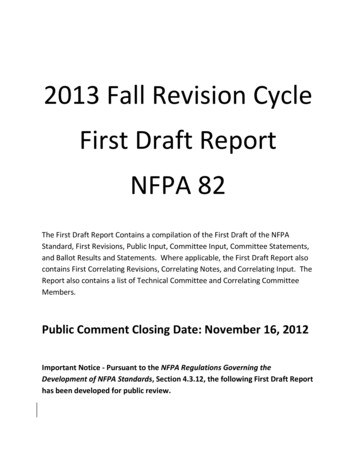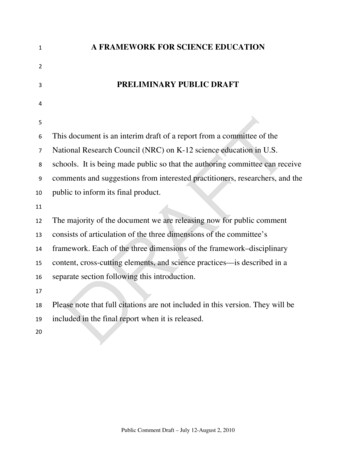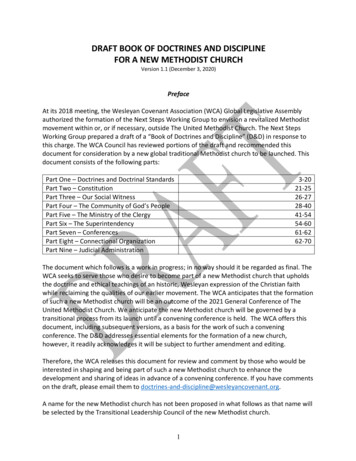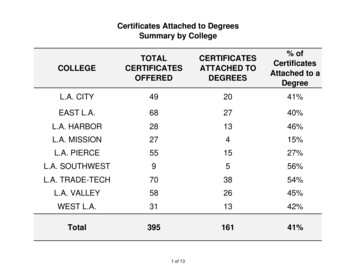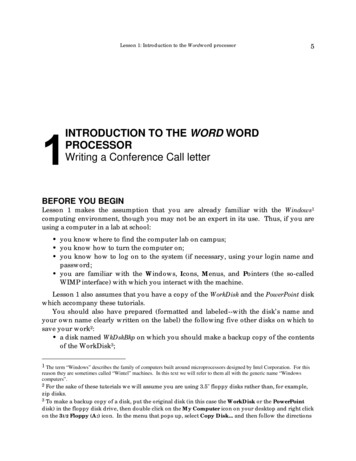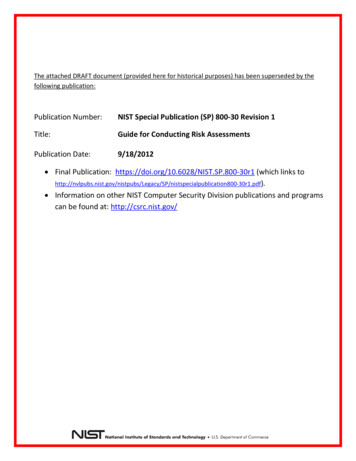
Transcription
The attached DRAFT document (provided here for historical purposes) has been superseded by thefollowing publication:Publication Number:NIST Special Publication (SP) 800-30 Revision 1Title:Guide for Conducting Risk AssessmentsPublication Date:9/18/2012 Final Publication: https://doi.org/10.6028/NIST.SP.800-30r1 (which links pecialpublication800-30r1.pdf). Information on other NIST Computer Security Division publications and programscan be found at: http://csrc.nist.gov/
Sept. 19, 2011SP 800-30 Rev. 1DRAFT Guide for Conducting Risk AssessmentsThe National Institute of Standards and Technology (NIST) announces the initial public draft of Special Publication800-30, Revision 1, Guide for Conducting Risk Assessments. Special Publication 800-30, Revision 1, is the fifth inthe series of risk management and information security guidelines being developed by the Joint Task Force, a jointpartnership among the Department of Defense, the Intelligence Community, NIST, and the Committee on NationalSecurity Systems. The partnership, under the leadership of the Secretary of Defense, the Director of NationalIntelligence, and the Secretary of Commerce, continues to collaborate on the development of a unifiedinformation security framework for the federal government to address the challenges of protecting federalinformation and information systems as well as the Nation’s critical information infrastructure.In today’s world of complex and sophisticated threats, risk assessments are an essential tool for organizations toemploy as part of a comprehensive risk management program. Risk assessments can help organizations: Determine the most appropriate risk responses to ongoing cyber attacks or threats from man-made ornatural disasters;Guide investment strategies and decisions for the most effective cyber defenses to help protectorganizational operations (including missions, functions, image, and reputation), organizational assets,individuals, other organizations, and the Nation; andMaintain ongoing situational awareness with regard to the security state of organizational informationsystems and the environments in which the systems operate.This publication changes the focus of Special Publication 800-30, originally published as a risk managementguideline. NIST Special Publication 800-39 has now replaced Special Publication 800-30 as the authoritative sourceof comprehensive risk management guidance. The update to Special Publication 800-30 focuses exclusively on riskassessments, one of the four steps in the risk management process. The risk assessment guidance in SpecialPublication 800-30 has been significantly expanded to include more in-depth information on a wide variety of riskfactors essential to determining information security risk (e.g., threat sources and events, vulnerabilities andpredisposing conditions, impact, and likelihood of threat occurrence). A three-step process is described includingkey activities to prepare for risk assessments, activities to successfully conduct risk assessments, and approachesto maintain the currency of assessment results.In addition to providing a comprehensive process for assessing information security risk, the publication alsodescribes how to apply the process at the three tiers in the risk management hierarchy--the organization level,mission/business process level, and information system level. To facilitate ease of use for individuals or groupsconducting risk assessments within organizations, a set of exemplary templates, tables, and assessment scales forcommon risk factors is also provided. The templates, tables, and assessment scales give maximum flexibility indesigning risk assessments based on the express purpose, scope, assumptions, and constraints established byorganizations.The public comment period for NIST Special Publication 800-30, Revision 1, is September 19 through November 4,2011. Please send comments to sec-cert@nist.gov
NIST Special Publication 800-30Revision 1Guide for ConductingRisk AssessmentsJOINT TASK FORCETRANSFORMATION INITIATIVEINFORMATIONSECURITYINITIAL PUBLIC DRAFTComputer Security DivisionInformation Technology LaboratoryNational Institute of Standards and TechnologyGaithersburg, MD 20899-8930September 2011U.S. Department of CommerceRebecca M. Blank, Acting SecretaryNational Institute of Standards and TechnologyPatrick D. Gallagher, Under Secretary for Standards and Technologyand Director
Special Publication 800-30Guide for Conducting Risk AssessmentsReports on Computer Systems TechnologyThe Information Technology Laboratory (ITL) at the National Institute of Standards andTechnology (NIST) promotes the U.S. economy and public welfare by providing technicalleadership for the nation’s measurement and standards infrastructure. ITL develops tests, testmethods, reference data, proof of concept implementations, and technical analyses to advance thedevelopment and productive use of information technology. ITL’s responsibilities include thedevelopment of management, administrative, technical, and physical standards and guidelines forthe cost-effective security and privacy of other than national security-related information infederal information systems. The Special Publication 800-series reports on ITL’s research,guidelines, and outreach efforts in information system security, and its collaborative activitieswith industry, government, and academic organizations.PAGE ii
Special Publication 800-30Guide for Conducting Risk AssessmentsAuthorityThis publication has been developed by NIST to further its statutory responsibilities under theFederal Information Security Management Act (FISMA), Public Law (P.L.) 107-347. NIST isresponsible for developing information security standards and guidelines, including minimumrequirements for federal information systems, but such standards and guidelines shall not apply tonational security systems without the express approval of appropriate federal officials exercisingpolicy authority over such systems. This guideline is consistent with the requirements of theOffice of Management and Budget (OMB) Circular A-130, Section 8b(3), Securing AgencyInformation Systems, as analyzed in Circular A-130, Appendix IV: Analysis of Key Sections.Supplemental information is provided in Circular A-130, Appendix III, Security of FederalAutomated Information Resources.Nothing in this publication should be taken to contradict the standards and guidelines mademandatory and binding on federal agencies by the Secretary of Commerce under statutoryauthority. Nor should these guidelines be interpreted as altering or superseding the existingauthorities of the Secretary of Commerce, Director of the OMB, or any other federal official.This publication may be used by nongovernmental organizations on a voluntary basis and is notsubject to copyright in the United States. Attribution would, however, be appreciated by NIST.NIST Special Publication 800-30, 85 pages(September 2011)CODEN: NSPUE2Certain commercial entities, equipment, or materials may be identified in this document in order todescribe an experimental procedure or concept adequately. Such identification is not intended to implyrecommendation or endorsement by NIST, nor is it intended to imply that the entities, materials, orequipment are necessarily the best available for the purpose.There may be references in this publication to other publications currently under development by NISTin accordance with its assigned statutory responsibilities. The information in this publication, includingconcepts and methodologies, may be used by federal agencies even before the completion of suchcompanion publications. Thus, until each publication is completed, current requirements, guidelines,and procedures, where they exist, remain operative. For planning and transition purposes, federalagencies may wish to closely follow the development of these new publications by NIST.Organizations are encouraged to review all draft publications during public comment periods andprovide feedback to NIST. All NIST publications, other than the ones noted above, are available athttp://csrc.nist.gov/publications.Public comment period: September 19 through November 4, 2011National Institute of Standards and TechnologyAttn: Computer Security Division, Information Technology Laboratory100 Bureau Drive (Mail Stop 8930) Gaithersburg, MD 20899-8930Electronic mail: sec-cert@nist.govPAGE iii
Special Publication 800-30Guide for Conducting Risk AssessmentsCompliance with NIST Standards and GuidelinesIn accordance with the provisions of FISMA,1 the Secretary of Commerce shall, on the basis ofstandards and guidelines developed by NIST, prescribe standards and guidelines pertaining tofederal information systems. The Secretary shall make standards compulsory and binding to theextent determined necessary by the Secretary to improve the efficiency of operation or security offederal information systems. Standards prescribed shall include information security standardsthat provide minimum information security requirements and are otherwise necessary to improvethe security of federal information and information systems. Federal Information Processing Standards (FIPS) are approved by the Secretary ofCommerce and issued by NIST in accordance with FISMA. FIPS are compulsory andbinding for federal agencies.2 FISMA requires that federal agencies comply with thesestandards, and therefore, agencies may not waive their use. Special Publications (SPs) are developed and issued by NIST as recommendations andguidance documents. For other than national security programs and systems, federalagencies must follow those NIST Special Publications mandated in a Federal InformationProcessing Standard. FIPS 200 mandates the use of Special Publication 800-53, asamended. In addition, OMB policies (including OMB Reporting Instructions for FISMAand Agency Privacy Management) state that for other than national security programsand systems, federal agencies must follow certain specific NIST Special Publications.3 Other security-related publications, including interagency reports (NISTIRs) and ITLBulletins, provide technical and other information about NIST's activities. Thesepublications are mandatory only when specified by OMB. Compliance schedules for NIST security standards and guidelines are established byOMB in policies, directives, or memoranda (e.g., annual FISMA Reporting Guidance).41The E-Government Act (P.L. 107-347) recognizes the importance of information security to the economic andnational security interests of the United States. Title III of the E-Government Act, entitled the Federal InformationSecurity Management Act (FISMA), emphasizes the need for organizations to develop, document, and implement anorganization-wide program to provide security for the information systems that support its operations and assets.2The term agency is used in this publication in lieu of the more general term organization only in those circumstanceswhere its usage is directly related to other source documents such as federal legislation or policy.3While federal agencies are required to follow certain specific NIST Special Publications in accordance with OMBpolicy, there is flexibility in how agencies apply the guidance. Federal agencies apply the security concepts andprinciples articulated in the NIST Special Publications in accordance with and in the context of the agency’s missions,business functions, and environment of operation. Consequently, the application of NIST guidance by federal agenciescan result in different security solutions that are equally acceptable, compliant with the guidance, and meet the OMBdefinition of adequate security for federal information systems. Given the high priority of information sharing andtransparency within the federal government, agencies also consider reciprocity in developing their information securitysolutions. When assessing federal agency compliance with NIST Special Publications, Inspectors General, evaluators,auditors, and assessors consider the intent of the security concepts and principles articulated within the specificguidance document and how the agency applied the guidance in the context of its mission/business responsibilities,operational environment, and unique organizational conditions.4Unless otherwise stated, all references to NIST publications in this document (i.e., Federal Information ProcessingStandards and Special Publications) are to the most recent version of the publication.PAGE iv
Special Publication 800-30Guide for Conducting Risk AssessmentsAcknowledgementsThis publication was developed by the Joint Task Force Transformation Initiative InteragencyWorking Group with representatives from the Civil, Defense, and Intelligence Communities in anongoing effort to produce a unified information security framework for the federal government.The National Institute of Standards and Technology wishes to acknowledge and thank the seniorleaders from the Departments of Commerce and Defense, the Office of the Director of NationalIntelligence, the Committee on National Security Systems, and the members of the interagencytechnical working group whose dedicated efforts contributed significantly to the publication. Thesenior leaders, interagency working group members, and their organizational affiliations include:U.S. Department of DefenseOffice of the Director of National IntelligenceTeresa M. TakaiAssistant Secretary of Defense for Networks andInformation Integration/DoD Chief InformationOfficer (Acting)Adolpho Tarasiuk Jr.Assistant Director of National Intelligence andIntelligence Community Chief InformationOfficerGus GuissanieDeputy Assistant Secretary of Defense (Acting)Charlene P. LeubeckerDeputy Intelligence Community ChiefInformation OfficerDominic CussattSenior Policy AdvisorMark J. MorrisonDirector, Intelligence Community InformationAssuranceBarbara FlemingSenior Policy AdvisorRoger CaslowChief, Risk Management and InformationSecurity Programs DivisionNational Institute of Standards and TechnologyCommittee on National Security SystemsCita M. FurlaniDirector, Information Technology LaboratoryTeresa M. TakaiActing Chair, CNSSWilliam C. BarkerCyber Security Advisor, Information Technology LaboratoryEustace D. KingCNSS Subcommittee Co-ChairDonna DodsonChief, Computer Security DivisionKevin DeeleyCNSS Subcommittee Co-ChairRon RossFISMA Implementation Project LeaderLance DubskyCNSS Subcommittee Co-ChairJoint Task Force Transformation Initiative Interagency Working GroupRon RossNIST, JTF LeaderGary StoneburnerJohns Hopkins APLJennifer FabiusThe MITRE CorporationKelley DempseyNISTDeborah BodeauThe MITRE CorporationDavid R. ComingsTenacity Solutions, Inc.Peter GouldmannDepartment of StateArnold JohnsonNISTPeter WilliamsBooz Allen HamiltonKaren QuiggThe MITRE CorporationChristina SamesTASCChristian EnloeNISTIn addition to the above acknowledgments, a special note of thanks goes to Peggy Himes andElizabeth Lennon of NIST for their superb technical editing and administrative support. Theauthors also gratefully acknowledge and appreciate the significant contributions from individualsand organizations in the public and private sectors, both nationally and internationally, whosethoughtful and constructive comments improved the overall quality, thoroughness, and usefulnessof this publication.PAGE v
Special Publication 800-30Guide for Conducting Risk AssessmentsDEVELOPING COMMON INFORMATION SECURITY FOUNDATIONSCOLLABORATION AMONG PUBLIC AND PRIVATE SECTOR ENTITIESIn developing standards and guidelines required by FISMA, NIST consults with other federal agenciesand offices as well as the private sector to improve information security, avoid unnecessary and costlyduplication of effort, and ensure that NIST publications are complementary with the standards andguidelines employed for the protection of national security systems. In addition to its comprehensivepublic review and vetting process, NIST is collaborating with the Office of the Director of NationalIntelligence (ODNI), the Department of Defense (DoD), and the Committee on National SecuritySystems (CNSS) to establish a common foundation for information security across the federalgovernment. A common foundation for information security will provide the Intelligence, Defense, andCivil sectors of the federal government and their contractors, more uniform and consistent ways tomanage the risk to organizational operations and assets, individuals, other organizations, and theNation that results from the operation and use of information systems. A common foundation forinformation security will also provide a strong basis for reciprocal acceptance of security authorizationdecisions and facilitate information sharing. NIST is also working with public and private sectorentities to establish specific mappings and relationships between the security standards and guidelinesdeveloped by NIST and the International Organization for Standardization and InternationalElectrotechnical Commission (ISO/IEC).PAGE vi
Special Publication 800-30Guide for Conducting Risk AssessmentsNotes to ReviewersNIST Special Publication 800-30, Revision 1, Guide for Conducting Risk Assessments, is the fifthin the series of risk management and information security guidelines being developed by the JointTask Force, a joint partnership among the Department of Defense, the Intelligence Community,NIST, and the Committee on National Security Systems. The partnership, under the leadership ofthe Secretary of Defense, the Director of National Intelligence, and the Secretary of Commerce,continues to collaborate on the development of a unified information security framework for thefederal government to address the challenges of protecting federal information and informationsystems as well as the Nation’s critical information infrastructure.In today’s world of complex and sophisticated threats, risk assessments are an essential tool fororganizations to employ as part of a comprehensive risk management program. Risk assessmentscan help organizations: Determine the most appropriate risk responses to ongoing cyber attacks or threats from manmade or natural disasters; Guide investment strategies and decisions for the most effective cyber defenses to helpprotect organizational operations (including missions, functions, image, and reputation),organizational assets, individuals, other organizations, and the Nation; and Maintain ongoing situational awareness with regard to the security state of organizationalinformation systems and the environments in which the systems operate.This publication changes the focus of Special Publication 800-30, originally published as a riskmanagement guideline. NIST Special Publication 800-39 has now replaced Special Publication800-30 as the authoritative source of comprehensive risk management guidance. The update toSpecial Publication 800-30 focuses exclusively on risk assessments, one of the four steps in therisk management process. The risk assessment guidance in Special Publication 800-30 has beensignificantly expanded to include more in-depth information on a wide variety of risk factorsessential to determining information security risk (e.g., threat sources and events, vulnerabilitiesand predisposing conditions, impact, and likelihood of threat occurrence). A three-step process isdescribed including key activities to prepare for risk assessments, activities to successfullyconduct risk assessments, and approaches to maintain the currency of assessment results.In addition to providing a comprehensive process for assessing information security risk, thepublication also describes how to apply the process at the three tiers in the risk managementhierarchy—the organization level, mission/business process level, and information system level.To facilitate ease of use for individuals or groups conducting risk assessments withinorganizations, a set of exemplary templates, tables, and assessment scales for common riskfactors is also provided. The templates, tables, and assessment scales give maximum flexibility indesigning risk assessments based on the express purpose, scope, assumptions, and constraintsestablished by organizations.Your feedback to us, as always, is important. We appreciate each and every contribution from ourreviewers. The very insightful comments from both the public and private sectors continue tohelp shape our publications and ensure that they meet the needs of our customers.-- RON ROSSFISMA IMPLEMENTATION PROJECT LEADERJOINT TASK FORCE LEADERPAGE vii
Special Publication 800-30Guide for Conducting Risk AssessmentsTable of ContentsCHAPTER ONE INTRODUCTION . 11.11.21.31.4PURPOSE AND APPLICABILITY .TARGET AUDIENCE.RELATED PUBLICATIONS .ORGANIZATION OF THIS SPECIAL PUBLICATION .2233CHAPTER TWO THE FUNDAMENTALS . 42.12.2RISK ASSESSMENT CONCEPTS . 6APPLICATION OF RISK ASSESSMENTS . 14CHAPTER THREE THE PROCESS. 193.13.23.3PREPARING FOR THE RISK ASSESSMENT .CONDUCTING THE RISK ASSESSMENT .MAINTAINING THE RISK ASSESSMENT .202432APPENDIX A REFERENCES. A-1. B-1ACRONYMS . C-1THREAT SOURCES. D-1THREAT EVENTS . E-1VULNERABILITIES AND PREDISPOSING CONDITIONS .F-1LIKELIHOOD OF OCCURRENCE . G-1IMPACT. H-1RISK . I-1RISK PRIORITIZATION. J-1SUMMARY OF TASKS . K-1APPENDIX B GLOSSARYAPPENDIX CAPPENDIX DAPPENDIX EAPPENDIX FAPPENDIX GAPPENDIX HAPPENDIX IAPPENDIX JAPPENDIX KPAGE viii
Special Publication 800-30Guide for Conducting Risk AssessmentsPrologue“. Through the process of risk management, leaders must consider risk to U.S. interests fromadversaries using cyberspace to their advantage and from our own efforts to employ the globalnature of cyberspace to achieve objectives in military, intelligence, and business operations.”“. For operational plans development, the combination of threats, vulnerabilities, and impactsmust be evaluated in order to identify important trends and decide where effort should be appliedto eliminate or reduce threat capabilities; eliminate or reduce vulnerabilities; and assess,coordinate, and deconflict all cyberspace operations.”“. Leaders at all levels are accountable for ensuring readiness and security to the same degreeas in any other domain.”-- THE NATIONAL STRATEGY FOR CYBERSPACE OPERATIONSOFFICE OF THE CHAIRMAN, JOINT CHIEFS OF STAFF, U.S. DEPARTMENT OF DEFENSEPAGE ix
Special Publication 800-30Guide for Conducting Risk AssessmentsCAUTIONARY NOTESCOPE AND APPLICABILITY OF RISK ASSESSMENTSRisk assessments are required for effective risk management and to inform decision making at all threetiers in the risk management hierarchy including the organization level, mission/business process level,and information system level. Furthermore, risk assessments are enduring and should be conductedthroughout the system development life cycle, from pre-system acquisition (i.e., material solutionanalysis and technology development), through system acquisition (i.e., engineering/manufacturingdevelopment and production/deployment), and on into sustainment (i.e., operations/support). There areno specific requirements with regard to: (i) the formality, rigor, or level of detail risk assessments; (ii)the methodologies, tools, and techniques used to conduct such risk assessments; or (iii) the format andcontent of assessment results and any associated reporting mechanisms. Therefore, organizations havemaximum flexibility on how risk assessments are conducted and employed and are encouraged toapply the guidance in this document in the manner that most effectively and cost-effectively providesthe information necessary for informed risk management decisions. Organizations are also cautionedthat risk assessments are often not precise instruments of measurement and reflect: (i) the limitations ofspecific assessment methodologies, tools, and techniques employed; (ii) the subjectivity, quality, andtrustworthiness of the data used; (iii) the interpretation of assessment results; and (iv) the skills andexpertise of those individuals or groups conducting the assessments. Since cost, timeliness, and ease ofuse are a few of the many important factors in the application of risk assessments, organizations shouldattempt to reduce the complexity of risk assessments and maximize the reuse of assessment results bysharing risk-related information across their enterprises, whenever possible.PAGE x
Special Publication 800-30Guide for Conducting Risk AssessmentsCHAPTER ONEINTRODUCTIONTHE NEED FOR RISK ASSESSMENTS TO SUPPORT ENTERPRISE-WIDE RISK MANAGEMENTOrganizations5 in the public and private sectors depend on information systems6 tosuccessfully carry out their missions and business functions. Information systems caninclude very diverse entities ranging from office networks, financial and personnelsystems to very specialized systems (e.g., weapons systems, telecommunications systems,industrial/process control systems, and environmental control systems). Information systems aresubject to serious threats that can have adverse effects on organizational operations (i.e.,missions, functions, image, or reputation), organizational assets, individuals, other organizations,and the Nation by exploiting both known and unknown vulnerabilities to compromise theconfidentiality, integrity, or availability of the information being processed, stored, or transmittedby those systems. Threats to information and information systems can include purposeful attacks,environmental disruptions, and human/machine errors and result in great harm to the national andeconomic security interests of the United States. Therefore, it is imperative that leaders andmanagers at all levels understand their responsibilities and are held accountable for managinginformation security risk—that is, the risk associated with the operation and use of informationsystems that support the missions and business functions of their organizations.Risk assessment is one of the key components of an organizational risk management process asdescribed in NIST Special Publication 800-39. Risk assessments identify, prioritize, and estimaterisk to organizational operations (i.e., mission, functions, image, and reputation), organizationalassets, individuals, other organizations, and the Nation, resulting from the operation and use ofinformation systems. The purpose of the risk assessment component is to identify: (i) threats toorganizations or threats directed through organizations against other organizations or the Nation;(ii) vulnerabilities internal and external to organizations; (iii) impact (i.e., harm) to organizationsthat may occur given the potential for threats exploiting vulnerabilities; and (iv) likelihood thatharm will occur. The end result is a determination of risk (i.e., the degree of harm and likelihoodof harm occurring). Risk assessments can be conducted at all three tiers in the risk managementhierarchy—including Tier 1 (organization level), Tier 2 (mission/business process level), and Tier3 (information system level).7 At Tier 1 and Tier 2, risk assessments are used to evaluate, forexample, systemic information security-related risks associated with organizational governanceand management activities, mission/business processes or enterprise architecture, and funding ofinformation security programs. At Tier 3, risk assessments are used to effectively support theimplementation of the Risk Management Framework (i.e., security categorization, securitycontrol selection, security control implementation, security control assessment, informationsystem authorization, and monitoring).85The term organization describes an entity of any size, complexity, or positioning within an organizational structure(e.g., a federal agency or, as appropriate, any of its operational elements) that is charged with carrying out assignedmission/business processes and that uses information systems in support of those processes.6An i
DRAFT Guide for Conducting Risk Assessments The National Institute of Standards and Technology (NIST) announces the initial public draft of Special Publication 800-30, Revision 1, Guide for Conducting Risk Assessments. Special Publication 800-30, Revision 1, is the fifth inFile Size: 936KBPage Count: 87

